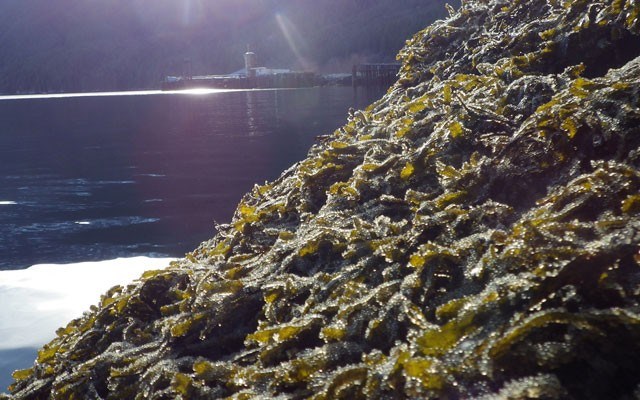Local herring spawn surveyors say their 2024 data, so far, shows similar spawning areas to past years, with at least one newly discovered area.
At an event at the Brackendale Art Gallery on May 28, over 50 people attended an end-of-the-season talk about the Search for Slhawt’/Herring project from the Átl’ka7tsem/Howe Sound Marine Stewardship Initiative (MSI).
“The intention with gathering this information is to develop a baseline dataset, so that decision-makers, policy, landholders, developers, whoever they are, first learn about the herring and the places that they’re using or spawning,” Matthew Van Oostdam, the project’s co-ordinator, told the crowd.
Van Oostdam shared information about several major spawning events throughout the season, which occurred as early as mid-February and continued until late April.
The mid-February spawn occurred near the Squamish Terminals, which has been one of the first places spawning occurs in recent years. Through March, spawn was found in the Mamquam Blind Channel, Cattermole Slough, Oceanfront Squamish and Squamish Estuary.
Van Oostdam said they also saw spawn in a relatively new area on the east side of Howe Sound north of Murrin Park in March. Van Oostdam said the area is called Txwn7us in Sḵwx̱wú7mesh Úxwumixw (Squamish Nation) language.
Finally, Foulger Creek and Woodfibre Creek were two other major spawning areas, both occurring in April. The Squamish Chief went on a short tour with Van Oostdam around this time to Foulger Creek to view the spawn.
“This is a lot of the repeated spawning areas,” Van Oostdam concluded. “It adds more to that baseline understanding of where herring are, apart from this new site that maybe reminds us that we need to be surveying more on the east side.”
He also said they’ve noticed some correlation between spawning events and the first quarter moon and new moon of the lunar cycle.
Beyond the information about the herring spawn surveys, two short films were shown. One film, created by local Kieran Brownie, showcased the surveying happening in Squamish, and the other showcased the herring spawn—and impacts on marine wildlife—happening near Vancouver Island. The film from Brownie should be available from MSI within the coming weeks.
Additionally, Virginie Chalifoux, a PhD student in Applied Animal Biology at the University of British Columbia, shared details with the group about how herring eggs develop. Generally, Chalifoux shared that eggs take only about 11 days to develop into larvae and some aspects of the development are visible to the naked eye.
Once larvae emerge, they are only about the size of a grain of rice and breathe through their skin before developing gills.
Van Oostdam said about 35 volunteers conducted surveying this season, completing over 500 hours of work.
“This is showing that there's a lot of people that love looking for these fish and their tiny little eggs,” he said.
A written report about the season, with some of the detailed maps from the talk, will be coming in the next several weeks. For more information about the project, visit howesoundguide.ca.




